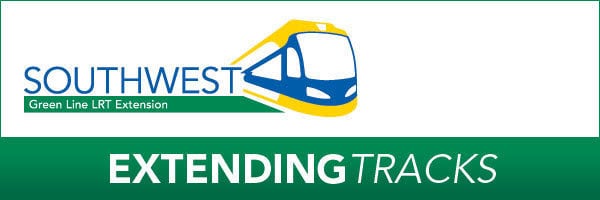
Southwest Green Line LRT Extension – EXTENDING TRACKS
February 2017 | Issue 16
Design and engineering effort nears completion
The Southwest LRT Project has finalized its civil design and is finalizing systems and Operations and Maintenance Facility designs in preparation for starting construction in 2017
The Federal Transit Administration (FTA) authorized the final preparations in late 2016 by approving the project’s entry into the Engineering phase of the New Starts funding process.
“The continued confidence and support from the FTA underscores this project’s strength as an efficient and effective way to connect people with jobs and expand opportunities in our region,” said Metropolitan Council Chair Adam Duininck. “I’m proud this project continues to maintain support not just at the federal level, but from our local community and business leaders as well.”
The FTA cleared the project’s environmental review earlier in 2016, paving the way for SWLRT to begin preparing bid documents for heavy construction.
The Full Funding Grant Agreement, which is expected later this year, would commit the FTA to pay half the capital costs of the project, or $928.8 million.
When the 14.5-mile line opens in 2021 as the METRO Green Line Extension, it will provide access to about 200,000 jobs.
Contractors interested in bidding for the work can learn more about what is to be constructed at a pre-bid conference and Disadvantaged Business Enterprise (DBE) mixer on March 3. Details for contract-related events will be posted on the Southwest LRT project website at: metrocouncil.org/swlrt/construction/events.
Coordinating work on 44 structures will be critical
Project staff began in late 2016 rolling out early details of how they will coordinate the timing of building or modifying 44 structures, including 29 new light rail, freight rail, roadway and pedestrian bridges.
“Structures that will be on time-critical paths to complete are a light rail bridge over Excelsior Boulevard in Hopkins, bridges over Louisiana Avenue in St. Louis Park, the Kenilworth tunnel in Minneapolis, and various bridges in Minnetonka and Eden Prairie,” project director Jim Alexander said.
While the individual structures themselves are not challenging designs, the logistics of coordinating the timing of their construction will be critical, as will dealing with poor soil conditions that will require pile driving, Alexander said.
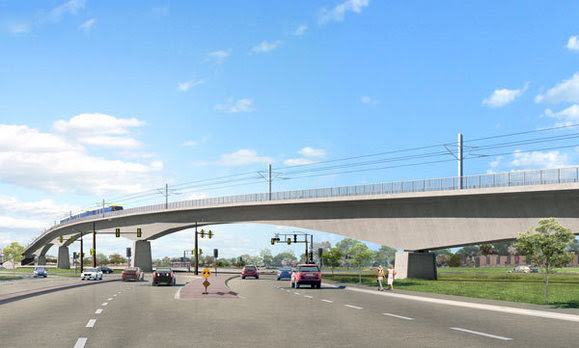
New structures along the METRO Green Line Extension include LRT bridges over Excelsior Boulevard and freight tracks in Hopkins (above) and over Nine Mile Creek and Flying Cloud Drive (below). The project also includes two cut-and-cover LRT tunnels, other new bridges, and modification of existing structures.
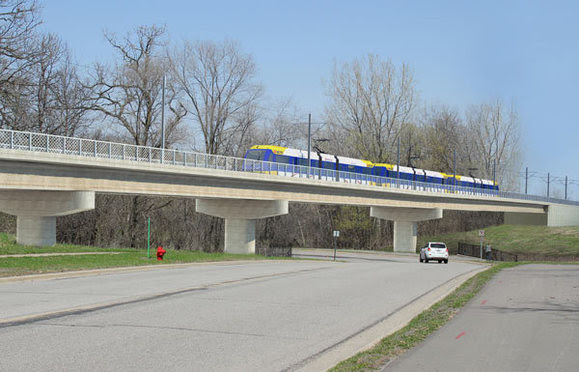
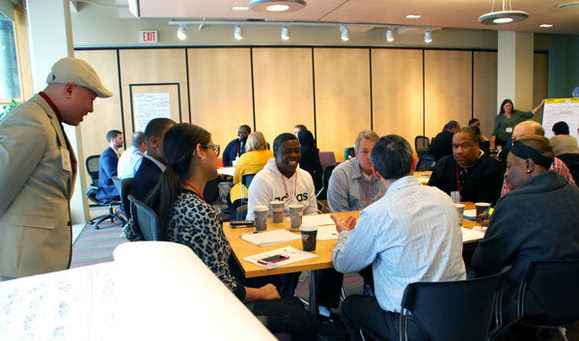
Above: participants in a Great Minds Summit event hosted by the Metropolitan Council in January 2017 discussed workforce and contracting needs for the Southwest LRT Project.
Next steps include invitation for bids, pre-bid conferences & DBE mixers
The project office issued an invitation for bids for the heavy civil construction contract on Feb. 14, 2017. The project plans to invite bids for the systems contract (electrical power, signaling and communications systems) in spring 2017, and for the operations and maintenance facility contract mid-2017. The Met Council could begin awarding contracts mid-year. Construction of the Southwest LRT Project will begin simultaneously in several locations along the line.
For more information, visit the Southwest LRT Construction Contract Procurement web page at
metrocouncil.org/swlrt/construction/procurement.
Animation shows how light rail will operate in Hopkins
New visualization of the METRO Green Line Extension shows interactions among trains, pedestrians and cars at stations and along route
Architectural design firm Duan Corp. provides a glimpse of the future on the Southwest LRT line with an animation of light rail trains at Downtown Hopkins Station.
The animation gives a birds’ eye view of how light rail trains, passengers, pedestrians and motorists will interact at the station, on an adjacent sidewalk and park-and-ride and at pedestrian crossings on Excelsior Boulevard and Eighth Avenue South. Light rail trains are shown operating on an LRT bridge to be built over Excelsior Boulevard, with vehicle traffic moving on the boulevard under the bridge.

Above: In a scene from the new animation, light rail trains enter Downtown Hopkins Stations (at left) while local buses stop on Excelsior Boulevard.
Below: Frank Duan

The animation was created by Maple Grove-based Duan Corp., a Disadvantaged Business Enterprise owned by Frank Duan, who also created three animations of different sections of the Green Line when it was under construction. The company, which Duan started in 2002, offers architectural design, urban design, interior design, laser scanning and 3D visualization services and employs six people.
Duan earned his bachelor’s degree in architecture from Tsinghua University in Beijing and his master’s degree in architecture from Iowa State University. Before starting his own company, Duan worked 10 years for a mid-size architecture firm, Cunningham Group.
“Our animation will help convey the vision of the Southwest LRT Project to the general public as we did for the Green Line,” said Duan, who is a DBE subcontractor for AECOM, Southwest LRT’s engineering services contractor.
The animation can be viewed on the Southwest LRT website at https://metrocouncil.org/swlrt/vis/Hopkins or on the Metropolitan Council’s YouTube channel at https://www.youtube.com/user/MetropolitanCouncil.
Local funders, feds demonstrate strong support through end-of-year actions
The Southwest LRT Project took big steps forward over the past several months. The Metropolitan Council approved funding agreements with corridor cities, Hennepin County, the Counties Transit Improvement Board, and the Minnesota Department of Transportation. Meanwhile, the Federal Transit Administration approved the project to enter engineering and finalize design plans in preparation for construction activities in 2017.
“When the cities, county, MnDOT and CTIB entered in to these agreements with us, they demonstrated strong support for SWLRT. The FTA’s action is their last step before committing to pay half the cost of building the line,” Metropolitan Council Chair Adam Duininck said.
The Met Council also approved agreements in December transferring the Kenilworth Corridor property from the Hennepin County Regional Railroad Authority to the Met Council and acquiring parking rights at a new facility near the Downtown Hopkins Station. Agreements with three freight railroads are progressing, including the purchase of railroad property for the project, the transfer of operating easements for one freight railroad and establishing operations and maintenance arrangements.
Agreements will ensure construction is efficient, cost effective, less disruptive
Known as Subordinate Funding Agreements (SFAs), the agreements with the cities and Hennepin County fall into three categories. They are local funding commitments, base project elements and locally funded work. The project anticipates that the agreements will be fully executed in early 2017.
Local funding commitments are funds that the cities and county agreed to contribute in 2015 that will go towards the construction of the project or cleanup of contaminated sites.
Base project element commitments are funds for elements requested to improve station access. The base project element SFAs are needed to receive 50 percent local funding matches from local project partners toward construction of base project elements that will improve access to the stations. These improvements include trails and stairs at Beltline, Wooddale and Blake; extension of Lynn Avenue; and, Louisiana trail underpass.
Locally funded work commitments are for elements that are outside the project scope and budget and are therefore paid 100 percent by the city, county or Minnesota Department of Transportation. The agreements allow for the transfer of funds to the Met Council to pay the project’s civil (or heavy) construction contractor for the work. No funds will come from the Federal Transit Administration, Counties Transit Improvement Board, Hennepin County Regional Railroad Authority or the Met Council because the elements are outside of project scope and budget. The elements will be added to the civil construction work undertaken by the project’s contractor instead of an outside contractor for efficiency and cost effectiveness, less disruption and easier coordination of work. Examples of work include trails, upgraded catenary poles, railings or lighting and traffic signal improvements.
More details about these agreements are available in the reports presented to the Council on Dec. 14, 2016.
Hopkins to get park-and-ride spaces for Downtown Hopkins Station
The Metropolitan Council will purchase park-and-ride space within an apartment building under construction near the Downtown Hopkins Station.
The Met Council approved a letter of agreement on Dec. 14 to negotiate and purchase 189 parking stalls at Eighth Avenue South and Excelsior Boulevard for up to $3.45 million. The parking spaces are part of Doran’s Moline apartment building. The Council will also purchase secured bicycle parking at the Moline.
Downtown Hopkins Station will have among the highest ridership on the future METRO Green Line Extension. The anticipated ridership at the Hopkins station is over 2,000 by 2040.
Nearly $6.8 billion in investment reported along LRT lines
Nearly $6.8 billion in investment has been tallied along the existing METRO Green Line and Blue Line and the proposed Southwest and Blue Line Extension Light Rail Transit (LRT) projects.
These investments include new construction such as the Optum headquarters in Eden Prairie, as well as redevelopment or rehabilitation of existing buildings, such as Custom House Apartments in downtown St. Paul and Riverside Plaza in Minneapolis. The total development likely exceeds $6.8 billion as many developments along the routes have not publicly disclosed their project value.*

The map above shows the locations of development and redevelopment projects within one-half mile of LRT stations. Only projects initiated after design work began on each LRT line are shown.
“Businesses continue making strategic investments along existing and planned light rail lines, demonstrating their conviction that light rail is a valuable asset to local communities along these routes,” Metropolitan Council Chair Adam Duininck said.
Kelly Doran, principal and founder of Doran Companies, says proximity to the Southwest Green Line extension is a major selling point in attracting tenants.
“Clearly, the decision to construct the Southwest Light Rail line is a significant boost to the marketing of The Moline, our multi-family apartment project opening in Hopkins this fall—but even more, to future development in the Southwest metro,” Doran said.
Connecting workers to jobs
There are already 64,300 jobs within one-half mile of the 15 planned Southwest LRT stations and another 16,600 jobs are expected to be added by 2035. Once completed, Southwest LRT will connect workers to job centers such as Park Nicollet Methodist Hospital, Downtown Hopkins, Opus Business Park, the Optum corporate headquarters, Golden Triangle Business Park, and Eden Prairie Center shopping mall.
Southwest Light Rail has the support of the business community. Three of Minnesota’s 17 Fortune 500 companies are located on the Southwest line, including CH Robinson, SuperValu, and UnitedHealth Group.
Another six Fortune 500 companies are on the existing LRT lines in downtown Minneapolis.
The Blue Line Extension has 16,200 jobs within one-half mile of its 11 planned new stations and is expected to grow to 20,800 jobs along the route. Target’s Northern Campus in Brooklyn Park is a major job center on the line.
Development highlights along individual LRT corridors
Green Line: $5.1 billion in development, with half outside downtown Minneapolis
The Green Line has seen $5.1 billion in development, up from the previously reported $4.2 billion in spring 2016. Half of that growth ($2.560 billion) has occurred outside downtown Minneapolis. The other half ($2.521 billion) has occurred along the mile of track with five stations shared by the Blue Line in downtown Minneapolis. Development highlights include mixed-income housing around the Minneapolis-St. Paul border between the Prospect Park and Raymond Avenue stations and general economic revitalization along the eastern end of University Avenue.
Southwest: More than half a billion dollars’ worth of development
The Southwest LRT Project, which will begin construction in 2017 and open in 2021, has experienced more than $515 million in development, up from $430 million reported in spring 2016. Since then, the project has secured all its local funding commitments and the Federal Transit Administration has approved the project to complete Engineering—the final phase before the FTA awards the Full Funding Grant Agreement ($928.8 million, expected in mid-2017), which is the federal government’s contractual commitment to pay half the capital costs. Development highlights include a mix of projects around the planned West Lake Street Station in Minneapolis, over one million square feet of office space around the City West Station in Eden Prairie, and a recently proposed 332-unit residential building near Opus Station.
Blue Line Extension: Nearly half a billion dollars’ worth of development
Development along the Blue Line Extension, which will begin construction in 2018 and open in 2021, has grown from $358 million reported in spring 2016 to $489 million. Commercial, industrial and hotel development is occurring north of Interstates 94/694 to Highway 610 at the line’s northernmost point.
The Blue Line Extension Project will connect downtown Minneapolis to the northwest suburbs. It requires a $149 million local funding commitment by June 2017 to realize a $753 million Full Funding Grant Agreement in 2018. The federal funds are dedicated to transit projects and cannot be used or repurposed for a roadway/highway system.
Blue Line: $700 million and counting in development
Development along the region’s first line, the METRO Blue Line, is valued at $699 million as compiled for only 15 of the 33 projects tracked on the non-shared portion of that corridor in south Minneapolis and Bloomington. Given the number of developments for which data has not been compiled, the actual value of development on this line is higher.
*Staff compiled data reported by developers about recently completed developments and projects that are under construction or design. Data also includes higher figures for previously reported projects whose development costs increased as projects advanced. The nearly $6.8 billion figure represents only projects whose value is known. For example, the value has been publicly reported for only 15 of the 33 projects tracked on the Blue Line, which opened in 2004, so the actual figure would be higher than $6.8 billion. Staff did not include figures for TCF Bank Stadium, Target Field, U.S. Bank Stadium or CHS Field.
More than 200 contractors, Disadvantaged Business Enterprises attend contractor open house
Staff presented design details Dec. 5 at a construction contractor open house at the Minnetonka Community Center to 230 representatives of contractors interested in bidding on the project. The open house included an information session and networking opportunity for Disadvantaged Business Enterprises (DBE) and prime construction bidders. Contractors interested in bidding on the project staffed 12 tables at the open house.

Above: Construction business networking.
Below: Contractors and representatives of other construction-related businesses listen to a presentation.
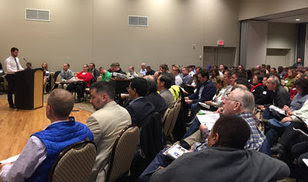
“Contractors are hungry for the chance to work on the Southwest LRT line. The Southwest LRT Project will create an estimated 7,500 construction jobs, totaling $350 million in payroll for Minnesota workers, who will come from all over the state,” project director Jim Alexander said.
About the Project:
The planned Southwest Light Rail Transit (LRT) Project (METRO Green Line Extension) will operate from downtown Minneapolis through the communities of St. Louis Park, Hopkins, Minnetonka, and Eden Prairie, passing in close proximity to the city of Edina. The line will connect major activity centers in the region including downtown Minneapolis, Methodist Hospital in St. Louis Park, downtown Hopkins and the Opus/Golden Triangle employment area in Minnetonka and Eden Prairie. Ridership in 2040 is forecasted at approximately 34,000 average weekday boardings. The project will interline with the METRO Green Line, which will provide a one-seat ride to destinations such as the University of Minnesota, state Capitol and downtown St. Paul. It will be part of an integrated system of transitways, including connections to the METRO Blue Line, the proposed METRO Blue Line Extension, the Northstar Commuter Rail line, a variety of major bus routes along the alignment, and proposed future transitway and rail lines. The Metropolitan Council will be the grantee of federal funds. The regional government agency is charged with building the line in partnership with the Minnesota Department of Transportation. The Southwest Corridor Management Committee, which includes commissioners from Hennepin County and the mayors of Minneapolis, St. Louis Park, Edina, Hopkins, Minnetonka, and Eden Prairie, provides advice and oversight. Funding is provided by the Federal Transit Administration, Counties Transit Improvement Board (CTIB), state of Minnesota and Hennepin County Regional Railroad Authority (HCRRA) and other project partners. The Southwest LRT Project website is www.swlrt.org

